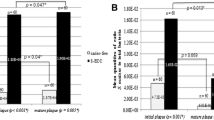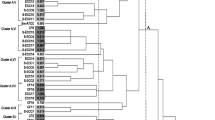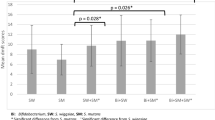Abstract
Objectives
The aim of this study was to examine the colonization of Streptococcus mutans and Streptococcus sobrinus in supra-gingival plaque samples and to determine their correlation with the prevalence of early childhood caries (ECC) in Thai children.
Materials and methods
A total of 344 Thai children, ages 3 and 5 years, were invited to participate in this study. Caries status of the children was examined. Supra-gingival plaque samples were collected. Quantitative real-time PCR was performed to evaluate DNA levels of S. mutans and S. sobrinus.
Results
Eighty-five percent of the children were colonized by S. mutans and 50.9 % of them were colonized by S. sobrinus. The prevalence of ECC was 43.8 % and 56.2 % among 3- and 5-year-old children, respectively, and was significantly associated with the presence of S. mutans and S. sobrinus. The severity of ECC was significantly correlated with increased DNA levels of the two bacteria. Children who were positive for S. mutans and S. sobrinus (Sm+/Sb+) were 8 times or 44 times more likely to experience ECC than children who were Sm−/Sb + or were Sm−/Sb−.
Conclusions
The study evidence further suggest that children colonized by both S. mutans and S. sobrinus are at the higher risk for ECC.
Clinical relevance
Molecular-based qPCR can be used to detect and quantify S. mutans and S. sobrinus colonization for epidemiological and clinical studies for ECC risk assessment.



Similar content being viewed by others
References
Abanto J, Carvalho TS, Mendes FM, Wanderley MT, Bonecker M, Raggio DP (2011) Impact of oral diseases and disorders on oral health-related quality of life of preschool children. Community Dent Oral Epidemiol 39:105–114. doi:10.1111/j.1600-0528.2010.00580.x
Sutthavong S, Cae-Ngow S, Rangsin R (2009) Oral health survey of military personnel in the Phramongkutklao Hospital, Thailand. J Med Assoc Thai 92(Suppl 1):S84–90
Pattanaporn K, Saraithong P, Khongkhunthian S, Aleksejuniene J, Laohapensang P, Chhun N, Chen Z, Li Y (2013) Mode of delivery, mutans streptococci colonization, and early childhood caries in three- to five-year-old Thai children. Community Dent Oral Epidemiol 41:212–223. doi:10.1111/cdoe.12013
Darojn K, Adunyanon S, Thinkamrop B, Bhumat N (2005) Effectiveness of fluoride varnish application by health officers in early childhood caries prevention. Journal of the Dental Association of Thailand 55(1-2):1–13
Vachirarojpisan T, Shinada K, Kawaguchi Y, Laungwechakan P, Somkote T, Detsomboonrat P (2004) Early childhood caries in children aged 6–19 months. Community Dent Oral Epidemiol 32:133–142. doi:10.1111/j.0301-5661.2004.00145.x
Peltzer K, Mongkolchati A, Satchaiyan G, Rajchagool S, Pimpak T (2014) Sociobehavioral factors associated with caries increment: a longitudinal study from 24 to 36 months old children in Thailand. Int J Environ Res Public Health 11:10838–10850. doi:10.3390/ijerph111010838
Dental Health Division (2008) Report on the 6th national oral health survey in Thailand (2006–2007). Department of Health, Ministry of Public Health. Nonthaburi, Thailand
Beighton D, Manji F, Baelum V, Fejerskov O, Johnson NW, Wilton JM (1989) Associations between salivary levels of Streptococcus mutans, Streptococcus sobrinus, lactobacilli, and caries experience in Kenyan adolescents. J Dent Res 68:1242–1246
Hirose H, Hirose K, Isogai E, Miura H, Ueda I (1993) Close association between Streptococcus sobrinus in the saliva of young children and smooth-surface caries increment. Caries Res 27:292–297
Loesche WJ (1986) Role of Streptococcus mutans in human dental decay. Microbiol Rev 50:353–380
Kohler B, Andreen I, Jonsson B (1984) The effect of caries-preventive measures in mothers on dental caries and the oral presence of the bacteria Streptococcus mutans and lactobacilli in their children. Arch Oral Biol 29:879–883
Tankkunnasombut S, Youcharoen K, Wisuttisak W, Vichayanrat S, Tiranathanagul S (2009) Early colonization of mutans streptococci in 2- to 36-month-old Thai children. Pediatr Dent 31:47–51
Okada M, Soda Y, Hayashi F, Doi T, Suzuki J, Miura K, Kozai K (2005) Longitudinal study of dental caries incidence associated with Streptococcus mutans and Streptococcus sobrinus in pre-school children. J Med Microbiol 54:661–665
Seki M, Yamashita Y, Shibata Y, Torigoe H, Tsuda H, Maeno M (2006) Effect of mixed mutans streptococci colonization on caries development. Oral Microbiol Immunol 21:47–52
Choi EJ, Lee SH, Kim YJ (2009) Quantitative real-time polymerase chain reaction for Streptococcus mutans and Streptococcus sobrinus in dental plaque samples and its association with early childhood caries. Int J Paediatr Dent 19:141–147. doi:10.1111/j.1365-263X.2008.00942.x
Kishi M, Abe A, Kishi K, Ohara-Nemoto Y, Kimura S, Yonemitsu M (2009) Relationship of quantitative salivary levels of Streptococcus mutans and Streptococcus sobrinus in mothers to caries status and colonization of mutans streptococci in plaque in their 2.5-year-old children. Community Dent Oral Epidemiol 37:241–249. doi:10.1111/j.1600-0528.2009.00472.x
Nurelhuda NM, Al-Haroni M, Trovik TA, Bakken V (2010) Caries experience and quantification of Streptococcus mutans and Streptococcus sobrinus in saliva of Sudanese schoolchildren. Caries Res 44:402–407. doi:10.1159/000316664
WHO (2013) Oral health surveys: basic methods. World Health Organization, France
Li Y, Ge Y, Saxena D, Caufield PW (2007) Genetic profiling of the oral microbiota associated with severe early-childhood caries. J Clin Microbiol 45:81–87
Chen Z, Saxena D, Caufield PW, Ge Y, Wang M, Li Y (2007) Development of species-specific primers for detection of Streptococcus mutans in mixed bacterial samples. FEMS Microbiol Lett 272:154–162
Yoshida A, Suzuki N, Nakano Y, Kawada M, Oho T, Koga T (2003) Development of a 5' nuclease-based real-time PCR assay for quantitative detection of cariogenic dental pathogens Streptococcus mutans and Streptococcus sobrinus. J Clin Microbiol 41:4438–4441
Loesche WJ, Eklund S, Earnest R, Burt B (1984) Longitudinal investigation of bacteriology of human fissure decay: epidemiological studies in molars shortly after eruption. Infect Immun 46:765–772
Emilson CG (1983) Prevalence of Streptococcus mutans with different colonial morphologies in human plaque and saliva. Scand J Dent Res 91:26–32
Gold OG, Jordan HV, Houte J (1973) A selective medium for Streptococcus mutans. Arch Oral Biol 18:1357–1364
Beighton D, Russell RR, Whiley RA (1991) A simple biochemical scheme for the differentiation of Streptococcus mutans and Streptococcus sobrinus. Caries Res 25:174–178
Bratthall D (1972) Immunofluorescent identification of Streptococcus mutans. Odontol Revy 23:181–196
de Soet JJ, van Dalen PJ, Appelmelk BJ, de Graaff J (1987) Identification of Streptococcus sobrinus with monoclonal antibodies. J Clin Microbiol 25:2285–2288
Cunnion DT, Spiro A 3rd, Jones JA, Rich SE, Papageorgiou CP, Tate A, Casamassimo P, Hayes C, Garcia RI (2010) Pediatric oral health-related quality of life improvement after treatment of early childhood caries: a prospective multisite study. J Dent Child (Chic) 77:4–11
Oho T, Yamashita Y, Shimazaki Y, Kushiyama M, Koga T (2000) Simple and rapid detection of Streptococcus mutans and Streptococcus sobrinus in human saliva by polymerase chain reaction. Oral Microbiol Immunol 15:258–262
Sato T, Matsuyama J, Kumagai T, Mayanagi G, Yamaura M, Washio J, Takahashi N (2003) Nested PCR for detection of mutans streptococci in dental plaque. Lett Appl Microbiol 37:66–69
Sanchez-Acedo M, Montiel-Company JM, Dasi-Fernandez F, Almerich-Silla JM (2013) Streptococcus mutans and Streptococcus sobrinus detection by polymerase chain reaction and their relation to dental caries in 12 and 15 year-old schoolchildren in Valencia (Spain). Med Oral Patol Oral Cir Bucal 18:e839–845
de Soet JJ, Toors FA, de Graaff J (1989) Acidogenesis by oral streptococci at different pH values. Caries Res 23:14–17
Kohler B, Birkhed D, Olsson S (1995) Acid production by human strains of Streptococcus mutans and Streptococcus sobrinus. Caries Res 29:402–406
Hughes CV, Dahlan M, Papadopolou E, Loo CY, Pradhan NS, Lu SC, Mathney JM, Bravoco A, Kent RL Jr, Tanner AC (2012) Aciduric microbiota and mutans streptococci in severe and recurrent severe early childhood caries. Pediatr Dent 34:e16–23
Becker MR, Paster BJ, Leys EJ, Moeschberger ML, Kenyon SG, Galvin JL, Boches SK, Dewhirst FE, Griffen AL (2002) Molecular analysis of bacterial species associated with childhood caries. J Clin Microbiol 40:1001–1009
Tanner AC, Mathney JM, Kent RL, Chalmers NI, Hughes CV, Loo CY, Pradhan N, Kanasi E, Hwang J, Dahlan MA, Papadopolou E, Dewhirst FE (2011) Cultivable anaerobic microbiota of severe early childhood caries. J Clin Microbiol 49:1464–1474. doi:10.1128/JCM. 02427-10
Acknowledgments
This study was supported by research funds from the Faculty of Dentistry of Chiang Mai University, Thailand, the New York University Research Challenge Fund Award, the New York University College of Dentistry Dean's Award for Student Summer Research, and the National Institute of Dental and Craniofacial Research (R03 DE015706, R01 DE013937).
Conflict of interest
The authors declare no conflicts of interest.
Author information
Authors and Affiliations
Corresponding author
Rights and permissions
About this article
Cite this article
Saraithong, P., Pattanaporn, K., Chen, Z. et al. Streptococcus mutans and Streptococcus sobrinus colonization and caries experience in 3- and 5-year-old Thai children. Clin Oral Invest 19, 1955–1964 (2015). https://doi.org/10.1007/s00784-015-1437-0
Received:
Accepted:
Published:
Issue Date:
DOI: https://doi.org/10.1007/s00784-015-1437-0




